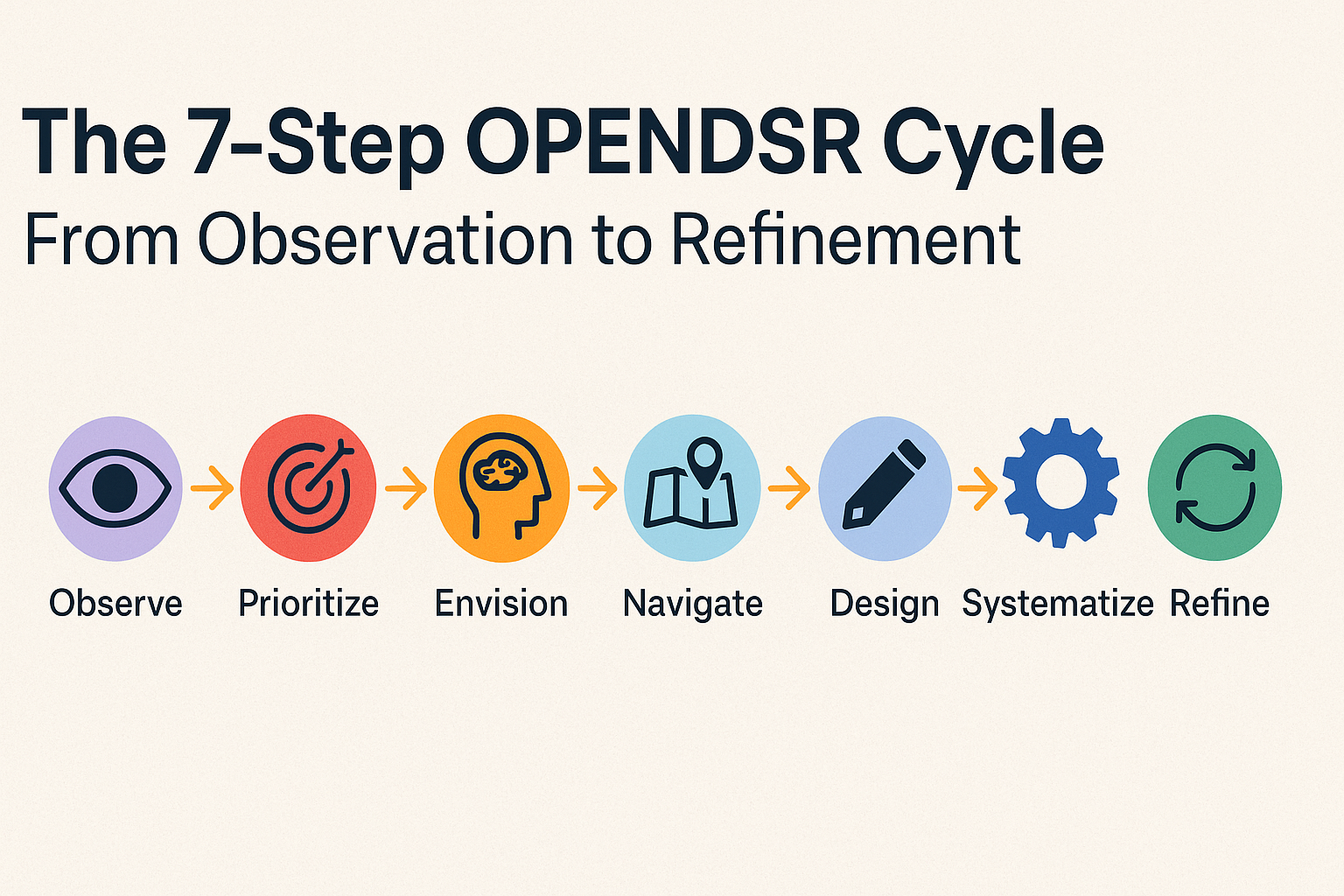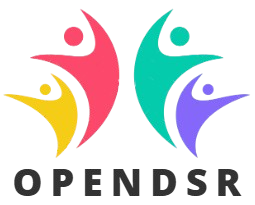
The 7-Step OPENDSR Cycle: From Observation to Refinement
Introduction: Why Experience Needs Rhythm, Not Projects
Employee experience (EX) isn’t built in annual surveys, one-off campaigns, or glossy HR programs. It’s built in everyday rhythms—morning check-ins, project handovers, promotion conversations, and even the silence between meetings.
The problem is that most organizations treat EX as a project rather than an operating rhythm. They launch initiatives, see initial excitement, but then momentum fades. Feedback gets collected but not acted upon. Promises are made but not sustained.
That’s why OPENDSR exists.
As a framework, OPENDSR (Open Platform for Empathy-led Navigation, Design Standards, and Real-Time Intelligence) provides not just pillars but a 7-step operating cycle that organizations can repeat endlessly. The cycle ensures that experience work doesn’t stall at intention. It flows—like a pulse, alive and evolving.
This article explores each step of the cycle, from Observation to Refinement, showing how organizations can turn signals into sustained cultural change.
Step 1: Observe 👀 – Sensing Before Solving
The first mistake most companies make is rushing to solutions. A new app here, a policy update there. But without truly observing what’s happening in the employee experience, solutions are often misaligned.
Observation is active attention. It means tuning into signals—spoken, unspoken, and emotional—before jumping into fixes.
-
How it looks in practice:
-
Weekly two-click check-ins (“Green / Yellow / Red” for energy levels).
-
Tracking shifts in participation (e.g., fewer people speaking in retros).
-
Reading tone in chat messages (short, abrupt responses can signal burnout).
-
Observing silence—not just words.
-
Case Example:
A digital marketing agency noticed morale dips but no direct complaints. By embedding a mood check in Slack, they captured real-time signals: unclear priorities, meeting fatigue, and loss of team rituals. Within weeks, managers had clarity they never would have gained from a quarterly survey.
Why it matters: Observation builds psychological safety. Employees see that signals—not just surveys—are noticed.
Step 2: Prioritize 🎯 – From Data to Decisions
Organizations often drown in feedback but starve for action. Prioritization is where leaders decide: What matters most right now?
Instead of reacting to the loudest voices, OPENDSR encourages using structured prioritization frameworks:
-
Frequency vs. Impact Matrix – Plot signals based on how often they occur and how deeply they affect trust, inclusion, or retention.
-
Lifecycle Mapping – Identify where in the employee journey (onboarding, promotions, exits) the pain points cluster.
-
Trust Test – Ask: “If we solved this, would employees feel more seen and supported?”
Case Example:
A SaaS company gathered over 1,000 feedback points. Instead of attempting everything, they prioritized three themes: onboarding, role clarity, and manager communication. Within 90 days, attrition dropped in two high-risk teams.
Why it matters: Prioritization prevents burnout—for both leaders and employees. It ensures resources target the highest-leverage improvements.
Step 3: Envision 🧠 – Co-Designing the Future State
Most EX programs fail because they’re designed for employees, not with them. Envision flips the script. It invites employees to co-create the desired experience.
-
How to Envision:
-
Host “experience labs” where cross-level employees brainstorm solutions.
-
Use journey-mapping exercises to surface friction points.
-
Ask aspirational questions: “What would ‘great’ feel like?”
-
Case Example:
A manufacturing company saw morale dips on factory floors. Instead of rolling out a generic recognition program, they invited frontline workers into co-design sessions. Together, they created micro-recognition rituals and simplified shift feedback. Productivity rose 9% in two months.
Why it matters: When employees shape the design, adoption skyrockets. They don’t just see change—they own it.
Step 4: Navigate 🗺️ – From Ideas to Implementation
Envisioning produces great ideas. But without navigation, ideas die in PowerPoint decks. Navigation is about sequencing change: Who does what, when, and how.
-
Tools for Navigation:
-
EX Roadmapping Canvas: Define owners, actions, timelines, and platforms.
-
Pilot vs. Scale Plan: Start with small tests, then expand.
-
Visible Milestones: Share progress openly so employees see momentum.
-
Case Example:
A retail chain co-created a shift feedback ritual but adoption lagged. Leaders created a 45-day EX roadmap in Notion, assigning each store lead small, weekly tasks. Adoption soared to 94% and became embedded across all locations.
Why it matters: Navigation transforms excitement into execution. It ensures that design lives in the real world, not on slides.
Step 5: Design ✏️ – Bringing Experience to Life
Design is where intention becomes visible. It’s not about aesthetics alone; it’s about making experiences consistent, inclusive, and human.
-
Design Standards to Apply:
-
Accessibility (screen-reader friendly, mobile-first).
-
Inclusive visuals and language.
-
Templates for critical conversations (onboarding, performance reviews, exits).
-
Multi-channel formats (Slack, email, face-to-face).
-
Case Example:
A global engineering company noticed inconsistent performance check-ins. Some managers excelled, others struggled. By rolling out an OPENDSR “Navigate 1:1” template—with prompts for recognition, growth, and inclusion—they created equity. Manager confidence rose 38% in six months.
Why it matters: Good design creates trust. Employees know what to expect, regardless of who their manager is.
Step 6: Systematize ⚙️ – Making Change Routine
Even the best designs fail if they rely on heroic effort. Systematization embeds changes into workflows, platforms, and rituals so they last.
-
How to Systematize:
-
Embed prompts into digital tools (e.g., automatic nudges in Teams invites).
-
Align rituals (e.g., every Friday pulse check).
-
Automate follow-ups without losing humanity.
-
Case Example:
A fintech startup piloted inclusive meeting protocols but adoption was uneven. By embedding a speaking-order rotation into Teams apps and including prompts in calendar invites, the practice became habitual. After three months, 82% of meetings followed the protocol.
Why it matters: Systematization ensures EX doesn’t depend on champions alone. It becomes how things are done here.
Step 7: Refine 🔄 – Learning in Motion
No experience design is perfect on the first try. Refinement turns EX into a living system—constantly adapting based on feedback.
-
Refinement Practices:
-
“Listening Fridays” – quick reflection forms on friction points.
-
Experience Journals – track what’s working, what’s unclear, what needs iteration.
-
Quarterly Reflection Loops – combine empathy (employee voice) with evidence (metrics).
-
Case Example:
A professional services firm redesigned its return-to-office rhythm. But the real shift came when they refined the design using weekly reflection forms. Insights revealed Tuesdays were the most stressful day. Leadership reduced Tuesday meetings, and well-being scores rose within a month.
Why it matters: Refinement proves the organization values learning over perfection. It keeps experience alive.
The Cycle in Action: From Linear to Rhythmic
While listed sequentially, the 7 steps are not a rigid line—they’re a loop. Organizations cycle through Observe → Prioritize → Envision → Navigate → Design → Systematize → Refine continuously.
-
A signal observed today may reprioritize tomorrow.
-
A design embedded last quarter may need refinement this quarter.
-
A systematized ritual may spark new observations.
This rhythm prevents stagnation and ensures EX remains responsive, adaptive, and human.
How OPENDSR Differs From Traditional EX Cycles
Traditional EX programs:
-
Depend heavily on surveys.
-
Treat EX as HR-owned.
-
Launch in bursts, fade quickly.
-
Rely on lagging indicators.
The OPENDSR cycle:
-
Uses signals in flow, not just surveys.
-
Treats EX as a shared responsibility.
-
Operates as a continuous rhythm.
-
Acts on real-time intelligence.
The difference is profound: traditional EX looks backward; OPENDSR looks forward.
Practical Tips for Starting the Cycle
-
Start small. Pick one team, one moment (like onboarding). Don’t over-engineer.
-
Use visible loops. Share “You said / We did” updates regularly.
-
Protect champions. Support, recognize, and lighten their load.
-
Anchor on empathy. Data matters, but human stories move leaders.
-
Measure lightly, act deeply. Focus on sentiment, friction, flow, and engagement.
Rhythm Is the Real Transformation
The brilliance of the 7-step OPENDSR cycle is not in its novelty, but in its practical rhythm.
-
It slows leaders down to observe before solving.
-
It directs focus with prioritization.
-
It invites employees in through envisioning.
-
It keeps momentum alive with navigation.
-
It builds trust through design.
-
It sustains change with systematization.
-
And it keeps learning alive with refinement.
In a world where employees no longer wait for annual surveys or one-off programs, OPENDSR transforms EX from episodic projects into living infrastructure.
Because employee experience isn’t a campaign. It’s the daily rhythm of work. And the OPENDSR cycle is the drumbeat that keeps it human.








